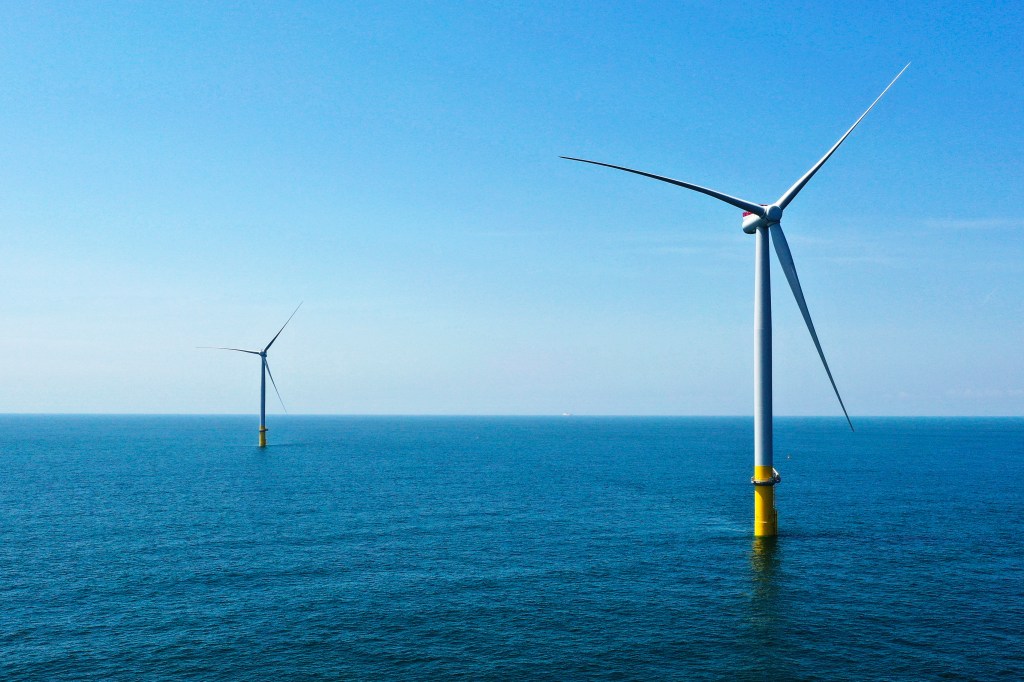A Norwegian energy company, Equinor, has secured a lease for an offshore wind farm area off the coast of Maryland, following a federal auction held on Wednesday. The area, located approximately 26 miles from the Delaware Bay mouth, lies further offshore than the two existing wind farm projects planned for the Maryland and Delaware coastline by U.S. Wind and Ãrsted.
Equinor, known for its oil and gas operations, has also invested significantly in renewable energy, aiming to achieve carbon neutrality by 2050. The company boasts a portfolio of offshore wind projects in the UK, including the Sheringham Shoal and Dudgeon wind farms, as well as the world's largest floating wind farm, Hywind Tampen, located off the Norwegian coast. The company also holds leases off the coasts of New York and California, showcasing its commitment to the US market.
Sam Salustro, Vice President of Strategic Communications at the Oceantic Network, a trade association for offshore wind, highlights Equinor's experience in the US market. "What Maryland is getting is not only an experienced international developer, but one whoâs been in the U.S. market for a while now, and understands how to work with locals, local manufacturing, state government, et cetera," Salustro explained.
Equinor's spokesperson, Magnus Frantzen Eidsvold, confirmed the company's commitment to the Maryland project, calling it "a long-term opportunity in an attractive region" with "offtake opportunities across several mid-Atlantic states."
Maryland's Governor, Wes Moore, has been a strong proponent of offshore wind energy, setting ambitious goals for the state. In June, he signed a memorandum of understanding with the US Department of the Interior to secure more offshore wind areas for Maryland, aiming for 8.5 gigawatts of wind power by 2031.
âGov. Moore has been already a champion of offshore wind in his short time in office," Salustro said. "Heâs risen the bar in Maryland. Heâs worked hard at attracting investments and building up a workforce."
The Maryland Energy Administration Director, Paul G. Pinsky, expressed his support, stating that securing the new lease area was a "major priority" for the administration. âYesterdayâs offshore wind energy lease auction is a decisive stride forward that will advance clean energy production, create new jobs, and work against climate change," Pinsky stated.
Despite the growing momentum surrounding offshore wind, some residents and leaders in Ocean City have voiced concerns regarding the potential aesthetic impact of the turbines, fearing disruption to ocean views and a detrimental effect on tourism. U.S. Representative Andy Harris, whose district includes Ocean City, has attempted to link periodic whale deaths in the mid-Atlantic to the developing wind farms. However, federal officials from the National Oceanic and Atmospheric Administration have dismissed this connection, citing ship strikes and fishing gear entanglements as more significant threats.
The auction for the Maryland lease area attracted five bidders, with an initial bid of approximately $10 million. Equinor emerged victorious after six rounds of bidding, securing the lease for approximately $75 million. The 101,443-acre site has the potential to generate an estimated 2 gigawatts of wind energy, enough to power around 900,000 homes.
The Department of Justice will conduct an antitrust review over the next 30 days before Equinor can formally submit a wind proposal to BOEM. It is important to note that the lease does not grant Equinor the right to construct turbines.
While the auction price was lower than some previous East Coast auctions, Salustro attributed this to supply chain issues caused by the COVID-19 pandemic, which have hindered industry progress and slowed projects. However, he noted the reduced cost as a positive, minimizing the potential for higher energy costs for consumers.
In addition to the Maryland lease, BOEM also leased an area off the coast of Virginia to Virginia Electric and Power Co. for $17.6 million. This company is already developing a nearby wind farm called Coastal Virginia Offshore Wind.
The development of offshore wind in Maryland is still in its early stages. U.S. Wind and Ãrsted have been working on their projects for over a decade, but both are still awaiting construction approval after navigating a complex regulatory process.
US Wind received a final environmental impact statement last month, moving the project closer to construction. CEO Jeff Grybowski expressed confidence that the project will be realized: âWe are well on our way to putting Marylandâs offshore wind goals that much closer to reality. We are now one step closer to securing all of our federal permits by the end of this year, and look forward to the day we can get steel in the water.â Grybowski expects construction to begin in 2025.
Ãrsted, previously partnered with US Wind, withdrew from its power purchase agreement with Maryland in January due to outdated terms, but remains committed to developing its wind farm.
BOEM is currently preparing for another auction for the Central Atlantic region, including Maryland waters, scheduled for 2026. With continued support from the state government and private investors, offshore wind energy is poised to play a significant role in Maryland's future energy landscape.
Article
Business

Offshore Wind Power: Norwegian Firm Wins Maryland Lease

